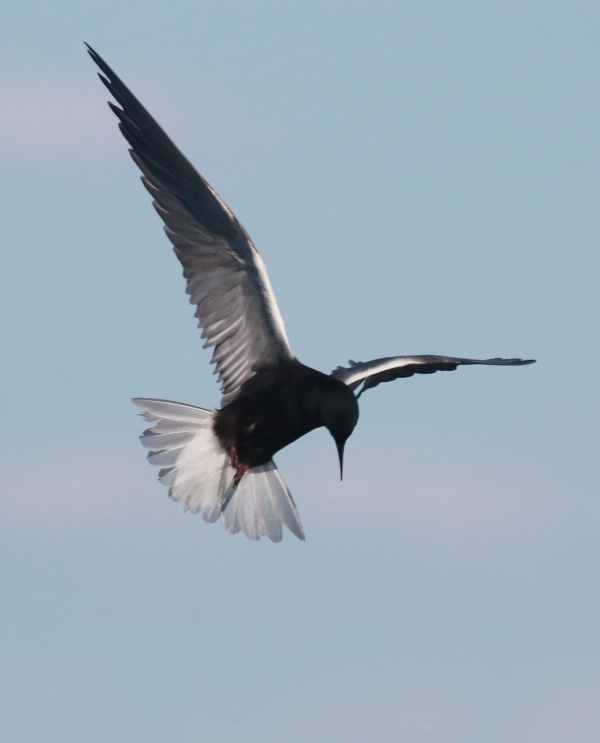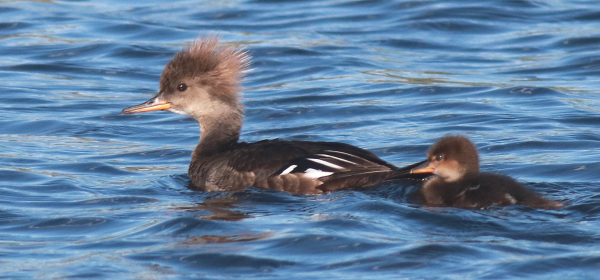
Black Terns add a lot of spice to area wetlands as they search for and dive after potential prey. This photo is especially pleasing as the action is paused while the tern stops to zero in on prey before its dive.

A Common Tern returns to a mate after a successful diving catch. Dakota wetlands support a rich variety and abundance of birds.

A particularly small brood of one Hooded Merganser duckling follows the female on the edge of a shallow pond it shared with another Hoodie hen with her brood of four ducklings and a Wood Duck with her brood of four.
|
Usually the sun is a determining factor in my birding activities, but this spring the wind has been a concern way too often. Last week the wind was particularly terrible, with strong gusting wind from the west one day, from the north a couple other days, and the southeast over the weekend. We’re talking 25 to 35 miles per hour, with gusts reaching 45! But Thursday evening provided a calming break in the wind for a few hours, and I made the most of it by revisiting McKenzie for the sixth week in a row, then surveying Long Lake National Wildlife Refuge – what fun.
Between Bismarck and McKenzie, I checked a favorite wetland that provided a glimpse of what would be one theme for the evening – duck broods. It appeared that during recent days many ducklings hatched successfully, and at my first stop three cavity nesting hens shared their newly hatched broods with me: A Wood Duck with 4 tiny ducklings, a Hooded Merganser with a brood of 4, and another Hoodie with a single duckling. I wondered where the female ducks found nesting cavities in the mostly treeless area, but there could be cavities or big nest boxes that I’m not aware of, yet. I managed a couple photos of the mergansers, then on to McKenzie.
The tiny town of McKenzie is all but surrounded by the expansive shallow wetland known as McKenzie Slough. Sure enough, the calm water permitted several newly hatched duck broods to be active in open areas, including 3 Mallard broods, 2 Northern Shoveler broods, and a tiny Blue-winged Teal brood. Whereas last week there were many pairs of Blue-winged Teal and Gadwalls along with Lesser Scaup and American Widgeons, it was quickly evident that many more lone males were present now. This change indicates the females are now incubating en masse, and I predict a huge hatch of a variety of duck species the last week of June. However, the really late nesters – Redheads and Ruddy Ducks – remain in pairs.
At one particularly promising opening in the expansive cattails, I was lured to stop by an American Coot feeding 3 downy hatchlings. There were also 2 drake Blue-winged Teal, a displaying male Ruddy Duck, and 2 Eared Grebes – plenty to keep me interested. One of the Eared Grebes would provide a memorable photo session that I share in the Bird Photography article in this issue of The Birding Wire – please check it out along with a few of the resulting photos.
Back to the subject of coot broods, there were at least as many young coots as ducklings to be seen. However, there were far fewer White-faced Ibis active than the week before, making me wonder if they were moving between McKenzie and Long Lake National Wildlife Refuge, located a few miles to the southeast. I decided to amble on to the refuge, passing many small wetlands and prairie areas along the way. That’s when Bobolinks became a dominant theme along the way. With the low wind conditions, male Bobolinks were very active and vocal as they performed their flight displays and tinkling songs, chased other males, and interacted with females that were much more obvious than usual. Bobolink prairies are among the finest examples of northern mixed grass prairies, and it was a beautiful night to enjoy the peak of spring greenery across the low hillsides. Grasshopper Sparrows were also actively courting mates and sending their buzzing songs across the plains.
Long Lake Refuge offered the usual community of waterbirds and ducks, although there was an unusual feeding flock of Marbled Godwits. On a newly planted wheat field adjacent to refuge wetlands I counted 56 godwits probing and picking across the newly worked field, along with an Upland Sandpiper and a Killdeer. As for any White-faced Ibis, I found none at the refuge, or anywhere between McKenzie and Long Lake – so much for the impression the ibis might be populating areas beyond the big slough.
Nest Checks
Friday was particularly windy again, but I wanted to check out the area surrounding my office after being a bit sidelined locally by intense wind during the week. First stop was the Western Grebe nesting colony with the impression that some clutches should hatch soon. All looked fine there, although the emergent vegetation was getting taller and thicker, hiding nests and incubating grebes better. Next stop proved to be a wind disaster!
I was awestruck to see the Ferruginous Hawk nest had been blown down by the intense wind! There was little nest material left in the willow tree, and no sign of nestlings or adults as I drove by. I turned around and, seeing an adult at the nest by that time, pulled off the side of the road and studied the situation with binoculars. Dang! It was a bit heart-breaking to see the adult male Ferrug standing on the scant remnants of the nest, looking down, picking up a branch and seemingly trying to replace it where the nest had been blown out. This continued a couple minutes until the male took flight in a tight circle, landing on a hill a couple hundred feet to the west.
I thought about walking in to the nest tree to check the fallen nest contents but didn’t have the heart to see the “crime scene” at that point – maybe another day. I expected the tragedy had taken place Monday, during an intense windstorm accompanied by more than an inch of rain and plenty of thunder and lightning that prompted tornado sirens to engage in the nearby town. As I pulled away, I noticed a large bare willow snag had been snapped off too. It was a favorite perch of Ferruginous Hawks and Great Horned Owls – and this photographer – but there will be no more portraits taken there.
Wind storms are a normal part of prairie life, and a percentage of hawk nests get destroyed by wind, but as you know, this site is one that has been very successful the past three years. I didn’t see any sign of the hawks again until Monday evening, when the pair was standing on the top of a hill a few hundred feet east of the nest tree. What’s your next move, I thought with some sympathy.
On the positive side, as I returned home I encountered a pair of Marbled Godwits, acting and calling very territorially on the edge of a wetland and prairie complex. I stopped, only to have the pair mob my vehicle, calling incessantly, flying overhead, diving, landing, taking flight and circling. The pair’s excitement also attracted the attention of a lone American Avocet and eventually a lone Willet that flew in to call and circle too. The intense territorial actions of the birds suggested I was interfering with nesting activities, so with that in mind I left abruptly, having done little more than add a little extra excitement to the location for a few moments.
One thing that’s obvious with all this wind, when it does calm, the activities of the area prairie and wetland birds are magnified and focused, the land is bathed in an orchestra of bird song, and the mating and nesting activities of birds becomes focused and prevalent. Next week should be especially exciting as we approach the first days of the summer season.
Article and photos by Paul Konrad
Share your bird sightings and photos at editorstbw2@gmail.com